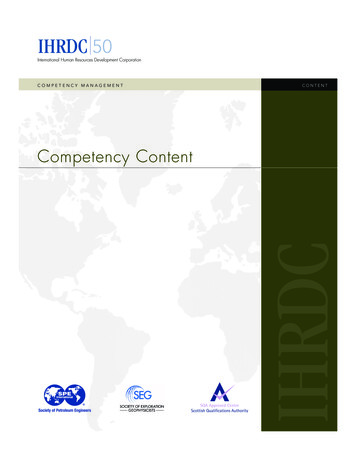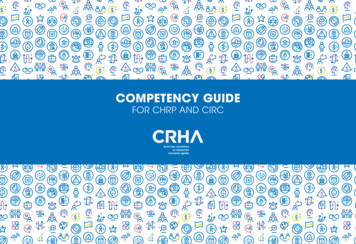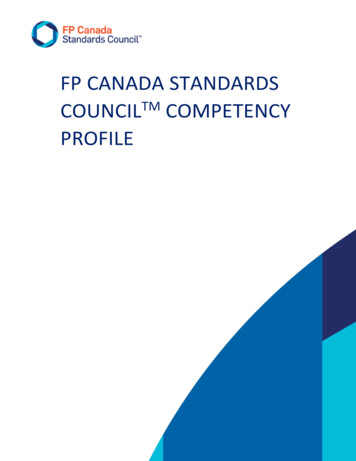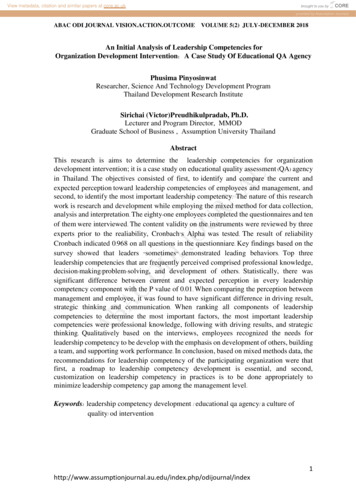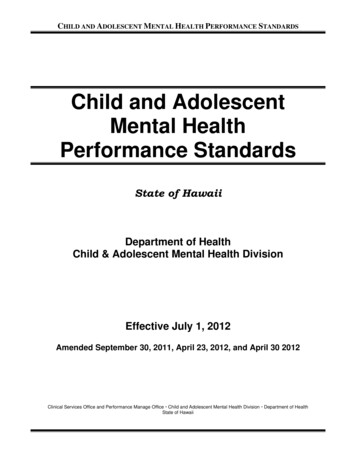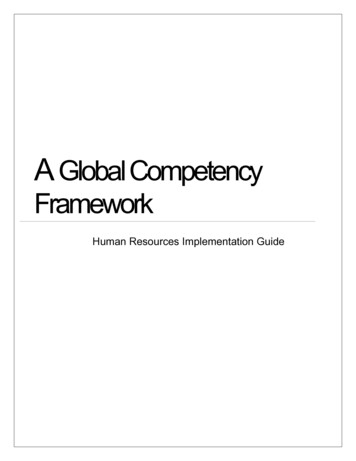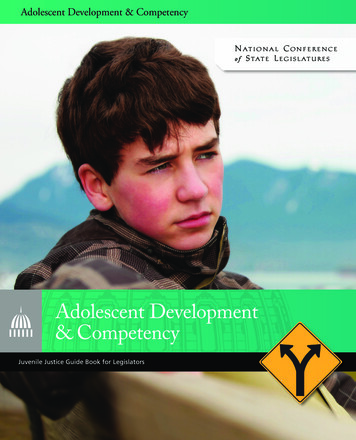
Transcription
Adolescent Development & CompetencyAdolescent Development& CompetencyJuvenile Justice Guide Book for Legislators
Adolescent Development & CompetencyIntroductionJuveniles are routinely accepted as different and treateddifferently than adults—both in social and legal contexts—basedon their age. The distinction is not so clear, however, in regardto criminal liability. Juveniles can be adjudicated as an adultin criminal court or as a juvenile in a delinquency proceeding;the variance exists even among juveniles of the same age whocommit comparable offenses.Juvenile Justice HistoryJuvenile justice policies are based on society’sperceptions and understanding of adolescents andtheir development. Juvenile justice aims not only tohold juvenile offenders accountable for their actions,but also to accommodate the ways in which theydiffer from adults. Therefore, shifts in publicopinion about the inherent capabilities andlimitations of juveniles usually are reflected injuvenile justice policies.Before the 20th century, juvenile offenders weretreated as adults. Under common law, children age 6and younger could not be held liable for their actions,but all others were not distinguished from adults.2The concept of a juvenile justice system cameabout in the late 19th century along with anewfound understanding of children. In 1899,Illinois established a separate juvenile court systemexclusively for children and separate from thecriminal court. By 1925, 48 states had followed suit.By the mid-1900s, it had become widely acceptedthat children were inherently different from adultsand should not be subject to the harsh treatment ofthe criminal justice system.
Juvenile Justice Guide Book for LegislatorsDevelopment of Juvenile JusticeEarly juvenile courts implemented benevolent andpaternalistic policies. The mere existence of thecourts represented the belief that children should notbe held solely and fully responsible for their actions.Instead, the courts acted to protect children and tomaintain their best interests. The underlying goal ofjuvenile courts was to rehabilitate offenders throughindividualized justice, with the ultimate beliefthat children have greater capacity for rehabilitation.Dispositions reflected the preference for treatment overpunitive measures. Juveniles rarely were transferred tocriminal courts, although that option was possible.Beginning in the 1960s, a series of Supreme Courtrulings required juvenile courts to make severalstructural changes. To meet both constitutionalrequirements and the rehabilitative goals, juvenilecourts became obliged to provide procedural dueprocess protections to juvenile defendants. Juveniledefendants today are provided most of the samerights—such as the right to an attorney—affordedto adult defendants. The main exception is thatjuvenile defendants do not have a constitutionallyprotected right to a jury trial in juvenile courts.3
Adolescent Development & CompetencyShifts in the Developmentof Juvenile JusticePublic sentiment shifted drastically beginning in the1980s. Juvenile crime rates, especially for homicides,rose during the 1980s and 1990s. The increase injuvenile crime, accompanied by heightened mediaattention, prompted a shift from a sympathetic viewof juveniles to one of fear. Juvenile offenders wereviewed as savvy criminals who had access to guns andcould commit serious, violent crimes. Rehabilitativepolicies were considered inadequate due to highrecidivism rates, and some serious offenders weretermed super-predators, unreceptive to treatmentoriented sentences. Consequently, more punitivepolicies began to replace rehabilitative ones, andthe transfer of juveniles to criminal courts becamemore common. Several states lowered the age atwhich juveniles could be within criminal courtjurisdiction; many states eased the methods fortransferring juveniles; and some states expanded thelist of offenses for which transfer is possible. Policiesincreasingly reflected the popular mantra of adulttime for adult crime.and impulsive nature that is characteristic ofadolescents makes them more susceptible to commitcrimes. Furthermore, some studies have shown thatjuveniles who commit crimes or otherwise engage insocially deviant behavior are not necessarily destinedto be criminals as adults.Adolescents Distinguishedfrom AdultsSociety already recognizes the inherent differencesbetween children and adults, so it is routine andsocially acceptable to treat youth differently inmany settings.Both federal and state laws restrict the rightsand activities of children. Every state sets an ageof majority, most at age 18; those who have notyet reached that age are subject to restrictions.State legislatures set age requirements for nearlyevery aspect of life—for example, to operate anautomobile, possess or purchase a firearm, purchasealcohol or tobacco products, and gamble.Juvenile crime rates have declinedin the past ten years.Most recently, along with declining juvenile crimerates, there has been a growing body of research onadolescent development, of which policymakers andother stakeholders have taken notice. The declinein crimes by juveniles has led the public to viewjuveniles as less threatening, diminished their statusas super-predators, and led them to be more receptiveto new research findings on adolescents. The researchshows that adolescent brains are not fully developeduntil about age 25, and the immature, emotional,4Neurobiological Development ResearchRecent advances in modern technology, particularlyin imaging technology, have provided more insightinto brain activity and maturation. Several studieshave concluded that adolescent brains are not as fullydeveloped as adults’; one such longitudinal studywas conducted by the chief of Brain Imaging in theChild Psychiatry Branch at the National Instituteof Mental Health. This study concluded that theaverage human brain is not fully developed until age25. Generally, the parietal lobes of the brain fullydevelop by age 16, but the temporal lobes are stilldeveloping and the frontal lobe continues to developinto the early 20s.
Juvenile Justice Guide Book for LegislatorsResearch on AdolescentCharacteristics and DevelopmentA growing body of biological, socialscience and developmental researchexists on adolescent development.Studies have suggested that adolescentscognition and psychosocial development continueinto the 20s. With diminished advanced cognition,including the ability to reason and to understand,adolescents are more vulnerable to psychosocialand emotional influences. Coupled with theirlack of experience and inefficiency in processinginformation, adolescents are less capable than adultsof making decisions.should be distinguished from adultsbased on their neurobiologicaldevelopment and for psychosocialResearch has yielded thereasons. Adolescent brains are not asconclusion that decision-makingdeveloped as adults, nor are adolescentscapabilities are diminishedas socially and emotionally mature,in adolescents.due to both biological reasons and theinherent lack of experience in youth.The frontal lobe, particularly in the prefrontalcortex region, is responsible for executive functionssuch as advanced cognition (including the ability toreason), regulating emotions, controlling impulses,and judging consequences. The frontal lobes arethought to undergo the greatest and most importantstructural changes during the adolescent years.Psychosocial and Developmental ResearchThe MacArthur Foundation Research Network onAdolescent Development and Juvenile Justice hasconducted psychosocial and developmental researchthat has corroborated the neurobiological researchon adolescent brains; the research has yielded theconclusion that decision-making capabilities arediminished in adolescents. Although the MacArthurResearch Network’s study shows that basic cognitiveabilities and intellectual maturity mirror adults’by the time adolescents reach age 16, advancedThe MacArthur Research Network’s social scienceand developmental psychology research identifiespsychosocial and developmental factors uniqueto adolescents that inhibit their decision-makingcapabilities. First, adolescents are more receptive andresponsive to the influences and opinions of theirpeers than those of adults, although this varies byage group within the general juvenile population.Emerging evidence also suggests that the hormonalchanges of puberty affect the adolescent brain’sability to process emotional and social informationto make them more sensitive to others’ opinions.Therefore, adolescents—who already value theopinions of their peers more highly than those ofadults—are even more vulnerable to peer influenceand pressure.Studies also show that adolescents have poor riskassessment skills, so they tend to be less risk-adversethan adults. Adolescents have trouble weighingrisks or valuing risks as accurately or as efficiently as5
Adolescent Development & Competencyadults. Adolescents tend to lack future orientation:they are more prone to think about short-term,rather than long-term, consequences. They alsohave a greater propensity to value benefits over risksand to engage in sensation-seeking activities; severalstudies have indicated that sensitivity to rewards isheightened during adolescence.Developmentally, adolescents also tend to be moreimpulsive and emotional—they are more inclinedto make impulsive decisions, engage in impulsivebehavior, and act recklessly compared to adults.Harvard Medical School’s Dr. Deborah YurgelunTodd explains that adolescents tend to act andreact more impulsively because they rely more onthe area of the brain that generates emotional gutreactions, rather than trying to thoroughly analyzeand rationalize. She also states that adolescents areless likely to consider the perspectives of others orall the potential ways to act or react. Developmentalstudies also have shown that the capacity forself-management and self-direction increasesthroughout adolescence.Adolescents in Criminal CourtAlthough most juveniles are adjudicated withinjuvenile systems, transfers into criminal courts havebecome increasingly common. The centerpieceof more punitive juvenile crime policies of the1980s and 1990s was legislation that enabledeasier and more frequent transfers into criminalcourts. Each year, roughly 250,000 juveniles areprosecuted in criminal courts. This number isestimated because it is hard to track the amountjuveniles processed in criminal court. Transfer lawswork with the underlying presumption that somejuveniles have the same criminal responsibility asadults and therefore should be treated in the samemanner. Although every state provides for at leastone transfer method, most have several methodsJuvenile Court JurisdictionMost states rely on common law to determineNearly all states also provide a maximum agethe minimum age for juvenile court jurisdiction.for juvenile court jurisdiction for dispositionalSome states have a statutory minimum; fivepurposes; the maximum age ranges fromstates set the minimum below age 9, and 1118 to 24, although most set it at age 20.states set the minimum at age 10. All states,Three states either do not specify a maximumby statute, provide a maximum age for originalor provide for the full disposition order tojurisdiction: two states set the maximum atbe completed within the juvenile system,age 15, 10 states at age 16, and 38 states andregardless of age.the District of Columbia at age 17.6
Juvenile Justice Guide Book for Legislatorsavailable. Three types of transfer laws are typical:judicial waiver laws, statutory exclusion laws, andprosecutorial discretion laws (also referred to asconcurrent jurisdiction laws).Each year, roughly 250,000 juvenilesare prosecuted in criminal courts.taken away. According to another study, even whenjuveniles have an accurate understanding of theirMiranda rights, they are less likely to assert them,especially when confronted by law enforcementofficials. Furthermore, if adolescents are unable toaccurately comprehend Miranda rights, questionsremain about whether their waiver of those rightsare, indeed, “knowing, intelligent, and voluntary.”Fifty-five percent of juvenilesLegal Competency as a Defendantfailed to demonstrate accurateIn evaluating legal competency to stand trial, theMacArthur Research Network studied a juvenile’sability to assist in and make crucial decisions regardinghis or her legal defense. It found that juveniles,especially those under age 15, are likely not able toexhibit sufficient competency in either juvenile orcriminal courts. Several aspects of being an adolescentcompromise competence as a defendant. For instance,juveniles are less likely to trust and communicateeffectively with their lawyers, both of which areessential elements in establishing a legal defense.comprehension of theIn addition, juveniles generally are less knowledgeableabout the legal system. Underdeveloped cognitiveand reasoning abilities, poor risk assessment skills,and shortsighted, emotional impulses further hinderjuveniles from understanding the proceedings againstthem and making informed decisions. One study, forexample, reported 55 percent of juveniles failed todemonstrate accurate comprehension of the Mirandawarnings. The study showed adolescents commonlyunderstand the right to remain silent to mean theright to remain silent until otherwise told. In fact,kids generally misunderstand the concept of a “right”as an entitlement more generally. It often is seen bychildren as something granted to them that can beMiranda warnings.Results of another MacArthur Research Networkstudy suggested that a substantial percentage ofjuveniles, especially those under age 15, lackedlegal competency as a defendant due to their owndevelopmental immaturity. This study provided adifferent perspective on competency by breakingjuveniles into different age groups. Generally, 11- to13-year-olds exhibited significantly less competencethan 14- to 15-year-olds who, in turn, exhibitedsignificantly less than 16- to 24-year-olds. The studyalso showed that 16- to 17-year-olds and 18- to24-year-olds exhibited similar levels of competence.Specifically, younger juveniles were less able toaccurately evaluate risks and understand long-termconsequences. Younger juveniles were more inclinedto make decisions that aligned with what theythought authority figures wanted, even if that meantconfessing or agreeing to a plea bargain.Furthermore, concern exists about the prevalence ofmental health issues and below-average intelligence7
Adolescent Development & Competencyamong juvenile offenders. Juveniles in the systemare three times more likely to experience mentalhealth issues than those who are not in the system.About two-thirds of juveniles under age 15 in juveniledetention have an IQ lower than 89, while only onethird in the general community have an IQ lowerthan 89. These issues magnify the already questionablecompetence inherent in juveniles. (Issues related tomental health also are discussed in the Mental HealthNeeds of Juvenile Offenders chapter.)As a result, several states allow juveniles to befound incompetent to stand trial on the basisof developmental immaturity, mental illness orintellectual disability, thereby providing juvenileswith greater procedural protections.Legal Competency forCriminal CulpabilityThere are also questions regarding whetheradolescents should be held to be as culpable as adults.In other words, should they be treated differentlydue to their immaturity? One response is that,because adolescents are biologically, psychologicallyand socially underdeveloped, their age and allcorresponding limitations of age should beconsidered as mitigating factors.Proponents of mitigating culpability for juvenilesargue that they should not be held as culpable asadults for several reasons. First, as discussed above,adolescents have diminished decision-making abilities.They lack future orientation, are more vulnerable topeer influence, have poor risk assessment skills, andare more emotional and impulsive.Another basis for mitigation is the extraordinarycircumstances inherent in being an adolescent. Forexample, adolescents are particularly vulnerable8Questions of Legal CompetencyIn response to the latest researchaffirming adolescents’ immature andunderdeveloped nature, ongoingquestions remain about a juvenile’scapacity to meet legal competency—competence to participate in legalproceedings generally and in termsof culpability. A juvenile’s lack ofcompetence raises disconcerting questionsabout the administration of justice in bothjuvenile and criminal courts.to external coercion, especially the opinions andinfluences of their peers. Some criminal justiceexperts theorize that, especially in high-crimecommunities, the average adolescent succumbs to,instead of resisting, peer pressure. Adolescents whochallenge peer pressure risk losing status, beingostracized, and even being assaulted. As minors, theyare more vulnerable because they lack the resourcesand the freedom to physically remove themselvesfrom the situation and re-locate. This is one reasonjuveniles are more prone to commit offenses in groups,as opposed to adult offenders who often act alone.Furthermore, some contend that culpability should bemitigated for juveniles because their character is notyet formed. As discussed above, adolescents continueto undergo biological, psychological and emotionalchanges and are more prone to engage in impulsive,risky behavior. Studies also have shown that criminalbehavior during adolescence is not necessarily areliable predictor for criminal behavior as an adult.
Juvenile Justice Guide Book for LegislatorsIn fact, some studies suggest that criminal behavioras an adolescent is more representative of anti-socialbehavior related to puberty, which most adolescentsoutgrow. Behavioral indicators of psychopathy inadults are common traits in the typical adolescent.In a MacArthur Research Network study, juvenileswere tested by the PCL-YV, the youth version ofthe adult psychopathy test, and results showed thatoverall test scores for youth declined over time moreso than for adults. Two-thirds of adults tested by theadult psychopathy test exhibited consistent scoresthroughout the test period.Federal StandardsWhile the Supreme Court has recognized thatjuveniles have many of the same due process rightsprovided to adult offenders—including a right tocounsel and, presumably, a right to be competentto stand trial—the Supreme Court has repeatedlydistinguished juveniles as inherently immature andtherefore warranting differential treatment fromadult defendants.In 2005, the Supreme Court, in Roper v. Simmons,held that it is cruel and unusual punishment tosentence to capital punishment a juvenile who isunder age 18 at the time the crime is committed.This decision indicates the Court regarded juvenilesas categorically different in the context of thedeath penalty.As basis for its opinion, the Court in Roper reliedon scientific evidence and noted three inherentdifferences between juvenile and adult offenders. First,juveniles, as a group, are inherently more susceptibleto immaturity, recklessness and irresponsible behaviorbecause they are underdeveloped biologically, sociallyand emotionally. Second, juveniles are more vulnerableto negative influences and peer pressure; they lackthe control over their immediate surroundings thatadults possess.Third, because juveniles continue to developphysically and emotionally, their characters arenot fully formed, and they are prone to exhibitnegative personality traits that are transitory and willnot follow into adulthood. Ultimately, the Courtfound that the culpability of a juvenile does notequal that of an adult and that no reliable methodexists to distinguish between the juveniles whocommit crimes because they are irreparably corruptand those whose actions emanate from normaladolescence. As in Atkins v. Virginia, which bannedthe death penalty for mentally disabled offenders,the punishment that is reserved for the worstoffenders with extreme culpability should not beimposed on those with diminished culpability.In 2010, the Supreme Court again distinguishedjuvenile offenders as distinct from adult offendersdue to their mitigated culpability. The Court inGraham v. Florida held that life imprisonmentwithout the chance of parole is unconstitutionalas applied to juveniles convicted of non-homicideoffenses. The Court made another categorical ruleregarding juvenile offenders and followed muchthe same rationale as the Roper decision. In makingits ruling, the Court recognized that a sentence oflife without parole is harsh, second only to capitalpunishment; therefore, juvenile offenders, whoseculpability is inherently mitigated by the fact of ageand who are not convicted of homicide must begiven an opportunity to avoid such a sentence. A2009 report published by Florida State Universitystated that, nationally, an estimated 109 juvenileswere sentenced to life without parole for nonhomicide offenses; although these juveniles camefrom eight states, most were Florida residents.9
Adolescent Development & CompetencyThe Court in Graham v. Floridaheld that life imprisonmentwithout the chance of paroleis unconstitutional as appliedto juveniles convicted of nonhomicide offenses.Trying and SentencingYouth as AdultsThe most common means of transfer is throughjudicial waiver laws, which traditionally wasthe only available method and remains the soleavailable method in eight states. Judicial waiverlaws essentially allow juvenile court judges to waivetheir jurisdiction so charges may be filed in criminalcourt. Judges must officially approve of the transferin a formal hearing or proceeding. Judicial waiversmay be discretionary, presumptive or mandatory.Discretionary judicial waivers, available in 45 states,give judges the option to waive jurisdiction incertain types of cases. There are usually eligibilityrequirements—albeit low standards that are easilymet—of minimum age, offense severity and previousrecord. Presumptive waivers, used in 15 states, applyto a certain category of cases, defined by statute,where a rebuttable presumption of transfer arises.Unless the offender presents evidence to rebut thepresumption that transfer is appropriate, the casewill be waived from juvenile court jurisdiction.Finally, mandatory waivers, used in 15 states,absolutely require transfers in certain cases so long ascertain requirements are met. Juvenile court judgeshave no discretion and merely confirm whetherthe cases meet the statutory requirements formandatory transfer.10Statutory exclusion laws exist in 29 states. Theselaws provide a statutory definition of delinquency ina manner that excludes certain offenses or cases fromoriginal court jurisdiction in juvenile courts. Thosecases, therefore, originate in and are within criminalcourt jurisdiction from the very beginning. Statutoryexclusion laws, along with mandatory judicial waiverlaws, are referred to as automatic transfers becausethey, without any discretion, automatically providefor juvenile offenders to be charged in criminalcourts. Thirty-eight states have some form ofautomatic transfer.Fifteen states have prosecutorial discretion lawsthat give prosecutors the authority to file charges,and therefore initiate proceedings, in juvenile orcriminal courts.These laws also are referred to as concurrentjurisdiction laws because both juvenile and criminalcourts have concurrent jurisdiction with each other.Prosecutors have broad discretion in determiningwhether to file charges in juvenile or criminal court.Unlike judicial waiver laws, prosecutorial decisions tocharge juveniles in criminal courts are not reviewable,since the decisions are made prior to any officialproceeding or evidentiary record and there usually areno statutory standards or factors to consider or guideprosecutors in their decisions.The vast majority of transfer laws were passed in thelast few decades. Currently, 44 states have mandatoryjudicial waiver laws, statutory exclusion laws, and/orprosecutorial discretion laws. These laws allowcategorical transfers or provide prosecutors with thediscretion to effectively allow such transfers. Thirtyfour states have once an adult, always an adulttransfer laws. Although some variations exist, theselaws generally dictate that juveniles previously
Juvenile Justice Guide Book for Legislatorsadjudicated as an adult will automatically be withincriminal court jurisdiction for any future offenses.The efficacy of transfer laws and criminal prosecutionof juvenile offenders is debatable; many havequestioned whether transfer laws advance publicsafety and promote deterrence. According to anindependent task force appointed by the directorof the Centers for Disease Control and Prevention,transfers of juveniles into criminal courts have notbeen a deterrent, and transfers typically increasedthe rates of violence among the transferred youth.In fact, youth adjudicated in the criminal system aremore likely to return to the system than are youth inthe juvenile system, even though most juveniles incriminal courts are not charged for serious, violentoffenses. Nevertheless, youth adjudicated as adultsare more likely to be re-arrested, to re-offend, to reoffend more quickly, and to re-offend with moreserious crimes.Youth adjudicated in the criminalsystem are more likely to return tothe system.A number of studies have focused on comparingthe recidivism rates for juveniles adjudicated incriminal courts with those who remained in thejuvenile system. A MacArthur Research Networkstudy, for example, compared juveniles in NewYork who were charged as adults at age 16 withjuveniles in neighboring New Jersey, where juvenilecourt jurisdiction extends to those under age 18.The study found that those adjudicated as adults inNew York were more likely to be re-arrested moreoften and more quickly for serious offenses thantheir counterparts in New Jersey. Another studythat compared the same groups found transferredjuveniles who served at least one year in prison were100 percent more likely to return to committingviolent crimes. In contrast, transferred youth in NewYork who were not sentenced to prison time were39 percent more likely to be re-arrested for violentoffenses. A Pennsylvania study found that youth whowere transferred to adult courts were 77 percent morelikely to be re-arrested than those who remained in thejuvenile justice system.Many potential explanations exist for the differentialin recidivism rates. Some theorize the culture andenvironment of adult facilities foster behavior injuveniles that increases their chances of recidivism.Juveniles in adult facilities, for example, are at anincreased risk for being physically and sexuallyassaulted; this, in turn, increases the chances theywill commit serious, violent offenses, especiallyif adequate therapy is not available to them. Theculture and social norms within adult facilities—valuing domination, exploitation and retaliation—foster anti-social, criminal behavior. Juveniles alsoare exposed to techniques they can use to commitcrimes when they return to society.A Pennsylvania study found thatyouth who were transferred toadult courts were 77 percent morelikely to be re-arrested than thosewho remained in the juvenilejustice system.The number of juveniles held in adult facilities hasincreased substantially. The National Council on11
Adolescent Development & CompetencyCrime and Delinquency reports that juveniles inadult jails have increased by 208 percent since 1990;at least 40 states either allow or require juvenilescharged as adults to be detained in adult jails. Ina single-day census in 2007, 7,703 juveniles werebeing held in adult jails nationwide, and 3,650 stateprisoners were under age 18.Housing juveniles in adult facilities has resulted in avariety of challenges, some of which may contributeto higher recidivism rates of juveniles adjudicated asadults. First, challenges exist for adult facilities staffwho must deal with the unique characteristics ofdeveloping and impressionable adolescent offenders.Typically, staff do not receive specialized training indealing with youth, nor are any adjustments made tophysical techniques to control juvenile inmates. Evenin the presence of specialized training, staffing ratiosmake it difficult to provide juvenile inmates with theindividual attention they may need. Adult facilitiesmay have as few as one correctional officer for every 64inmates, compared to juvenile facilities that typicallyhave one staff member for every eight inmates.Second, adult facilities face challenges as theyattempt to accommodate the programming andtreatment needs of juvenile offenders. Althoughjails are intended to provide temporary, transitionaldetainment, in reality, many youth may spendan extended period of time in jail while awaitingtrial. Although most prisons have GED programs,offerings may be limited and there may be longwaiting lists for higher education classes.Adult facilities also struggle to deal with the mentalhealth needs of juvenile offenders. As discussed in theMental Health Needs of Juvenile Offenders Chapter,a high prevalence of mental health issues existamong juvenile offenders. Access to treatment andmedication for behavioral management and mental12Issues Related toDetention & ImprisonmentAs more juveniles are charged andprosecuted as adults, more adolescents aredetained and imprisoned in adult facilities.Under the Juvenile Justice and DelinquencyPrevention Act which was re-authorizedin 2002, juveniles under juvenile courtjurisdiction cannot be held in adult jails,except in very limited circumstances. Insuch circumstances, jails must abide by thesight and sound separation requirementthat restricts juvenile offenders fromhaving contact with adult offenders.These provisions apply only to youth withinjuvenile court jurisdiction, not to thosewho are charged and prosecuted as adults.illness is part
criminal courts, although that option was possible. Beginning in the 1960s, a series of Supreme Court rulings required juvenile courts to make several . and developmental psychology research identifies psychosocial and developmental factors unique to adolescents that inhibit their decision-making capabilities. First, adolescents are more .


